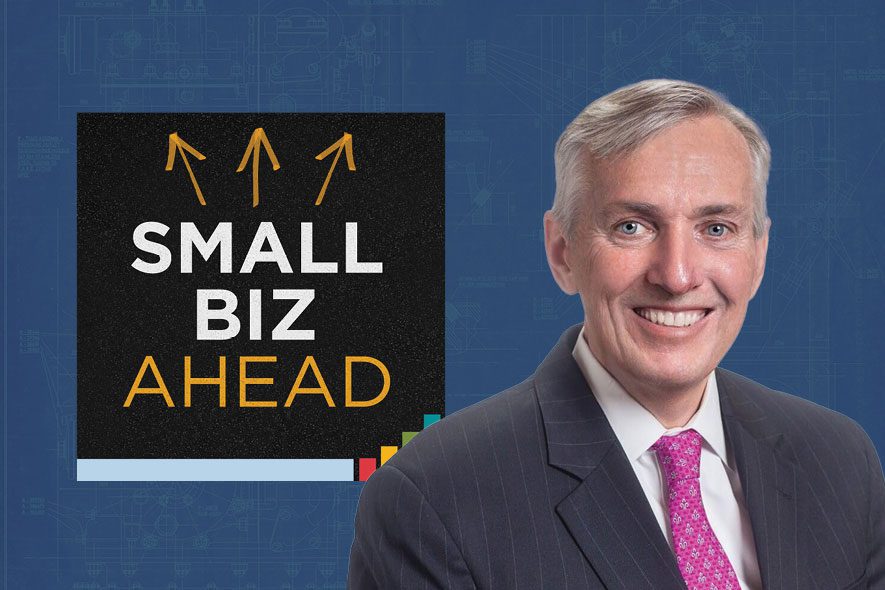Transcript
The views and opinions expressed on this podcast are for informational purposes only, and solely those of the podcast participants, contributors, and guests, and do not constitute an endorsement by or necessarily represent the views of The Hartford or its affiliates.
You’re listening to the Small Biz Ahead podcast, brought to you by The Hartford.
Our Sponsor
This podcast is brought to you by The Hartford. When the unexpected strikes, The Hartford strikes back for over 1 million small business customers with property, liability, and workers compensation insurance. Check out The Hartford’s small business insurance at TheHartford.com.
Gene (00:01):
Hey everybody, this is Gene Marks and welcome to this week’s episode of the Hartford Small Biz Ahead podcast. Thank you so much for joining me. Wanna talk to you more about inflation. Just in the past week, the Bureau of Labor Statistics announced their inflation numbers and it’s good news. Inflation now in the most recent month is, running at around 4%, which is less than a half than what it was like a year, year and a half ago. And more importantly, the producer price index, which is that leading indicator of prices that’s like the price of like materials and goods and products, even labor that businesses are spending on to turn into their final products. So it’s like a leading indicator of inflation, that really dropped. It’s down to 1.1% on an annual basis. So good news, costs are coming down.
Gene (00:50):
That is great. However, you may not be believing me because when I speak to industry groups around the country and I’ve been speaking to a bunch of them of late… people in the manufacturing distribution service groups. I spoke to a few associations of CPAs in Minnesota and New Jersey. When we talk about inflation being at 1.1% for producer prices, they’re looking at me like I’ve got, I’m losing my mind. Because most businesses for their core prices are still seeing costs that are much higher than that. And in fact, most businesses, again, across all industries, including construction, manufacturing, distribution, service, they’re seeing prices compared to two years ago more than double digit prices. I mean, businesses are still struggling with a lot higher costs than what they were ever struggling with before and they’re trying to get their arms around that. So the question is, what do you do if you’re looking at higher costs?
Gene (01:44):
How can you keep your costs down? What do you do to navigate your business through this? Now I’ve only got less than 10 minutes with you, so I can’t give you all of my thoughts in those 10 minutes cause I do have a bunch. But I do wanna share with you just a few different ideas, things I’ve touched about before on previous podcasts. But I also wanna re-emphasize cause there’s so important this year. Number one. Number one, you may have to increase prices still, there’s only so much you can do to manage your costs. We all get that. Just please, if you’re gonna increase prices, target those price increases, leverage the data that you have. You probably have QuickBooks or Epicor, Dynamics or Sage or SAP, whatever accounting system that you have, compare it to the way your parents and grandparents were running their businesses 30 years ago, 40 years ago when there was also inflation. You’ve got way more data than them. I mean you do. So analyze that data, target your price increases, pick on certain customers that aren’t making you enough profits. Pick on certain products with lower margins. Regions that might be able to absorb or industries that are doing better than other industries that could also absorb a price increase.
Gene (02:58):
My smartest clients are not just doing across the board price increases, they are raising the prices of their products on services in a very select and diligent way based on their data. So this year, unless you really wanna anger people, you don’t wanna anger, really think hard about who you’re gonna apply these price increases to and make it count and leverage your data to do just that. That’s number one. Another thing that I’m seeing a lot of my clients do is they’re practicing something called shrinkflation. I talked about this before but I’m gonna talk about it again because it’s pretty popular. Shrinkflation is when you sell a little less of something but for the same price. Now, I know that might sound immoral or unethical, but believe me when I tell you, a lot of the big brands that are out there are doing that to all of us right now.
Gene (03:50):
They’re selling like a little less product, but they’re not changing their price, which is the same thing as inflation. It’s just called shrinkflation because it’s all about margins. So what I want you to do is, I want you to take another look at the products and services that you’re offering to your customers. Is there anywhere where you can offer just a little bit less. A smaller unit, less of a little bit of a product, less of a service that you provided in the past, but keeping your price the same? That way, you don’t have to raise prices, but you can protect your margins. One big way, I’ve seen this with a lot of my clients, has been through freight. I mean it used to be to match Amazon, you would offer free shipping anywhere in the country. Even Amazon has been pulling back on that of late and a lot of businesses are doing the same.
Gene (04:36):
So maybe you don’t offer free shipping, depending on where it is or what the size of the order is. You still keep the price of the order the same, but now you’re just charging a little bit extra for freight. So wherever you can do shrinkflation, do shrinkflation. So that’s my second piece of advice. My third piece of advice is trying to grab as much interest as you can for your money in this high interest and sticky inflation environment that we’re in right now. Your money, if it’s not liquid, should be working for you. Yes, you should put it in treasury bonds. I know there were some banks that got into trouble because they put their money into treasury bank bonds and then they had to sell those bonds because they needed the cash. When you sell a treasury bond in a high and growing interest environment, you’re gonna lose money on it if you sell it before maturity.
Gene (05:22):
So don’t do that. You gotta consider that if you put your money into a T-bond, it’s going to be illiquid. But that’s fine because treasury bonds can pay you anywhere from three to 5% right now. Keep you fairly current with inflation. As long as you’re okay to wrap the money up in them. Just make sure you hold them until maturity. That should be your goal. The second thing to consider is certificates of deposits. CDs, same thing as treasury bonds. More and more banks are offering CDs at very interesting rates. Again, three to 5%. Now again, when you buy a CD, you’re tying up your money. If you try to sell a CD early, you’re gonna lose some money. So your cash has gotta be non-liquid, right? You don’t need it. But even if you do think you might need the cash in the future, do what a lot of my other clients are doing.
Gene (06:09):
They’re laddering their CDs, they take their money and they buy CDs that mature in three months, six months, one year, two years, five years. And then as those CDs come and mature, you can then roll them over into new CDs or take the cash and use it for operations. That way you can maximize your return on investment and get the most interest that you can possibly get. So let me make sure I recap this for all of you guys listening. I know inflation is coming down, but it’s still a lot higher than what it was just two years ago. And we’re grappling with those higher prices. Yes, you’re probably still gonna have to raise prices this year, but be very smart about it. Leverage your data and target those customers, products, services, industries, regions that can absorb those price increases. Okay? Practice shrinkflation.
Gene (06:58):
If there is a way that you can sell a little less of something or provide just a little bit less service, but still charge you the same price, well that’s kind of the same as raising your prices, isn’t it? But it’s protecting your margins. And I’m telling you, a lot of big brands and companies that you and I recognize, they’re doing that to us all the time. And finally, when it comes to your own cash, try to maximize your interest earnings, put your money in treasury bills or bonds, it’s fine. Just hold them to maturity. Take that same money and put it into CDs. Certificates of deposits with the bank. You can roll them over. So you can have a CD for three months, six months, a year, rolled over. So your money, all of your money isn’t tied up in a liquid, but it can still be earning more interest than if it’s just sitting in your checking account doing nothing at all.
Gene (07:43):
Those are just some thoughts for dealing with your cash in a high interest rate, sticky inflation environment that we’re in right now. I’ve got more advice as well. Maybe I’ll cover that on another episode of our Hartford Small Biz Ahead podcast. But for now, you have been listening to the Hartford Small Biz Ahead podcast and my name is Gene Marks. If you need any tips or advice or help in running your business or would like to watch one of our many great podcasts that we do where we interview some really fascinating people to help you run your business, visit us at SmallBizAhead.com or SBA.TheHartford.com. Thanks so much for listening. Hope you got some good information out of this conversation and we will see you again next week with more advice for running your business. Take care.
Download Our Free eBooks
- Ultimate Guide to Business Credit Cards: The Small Business Owner’s Handbook
- How to Keep Customers Coming Back for More—Customer Retention Strategies
- How to Safeguard Your Small Business From Data Breaches
- 21 Days to Be a More Productive Small Business Owner
- Opportunity Knocks: How to Find—and Pursue—a Business Idea That’s Right for You
- 99 New Small Business Ideas





